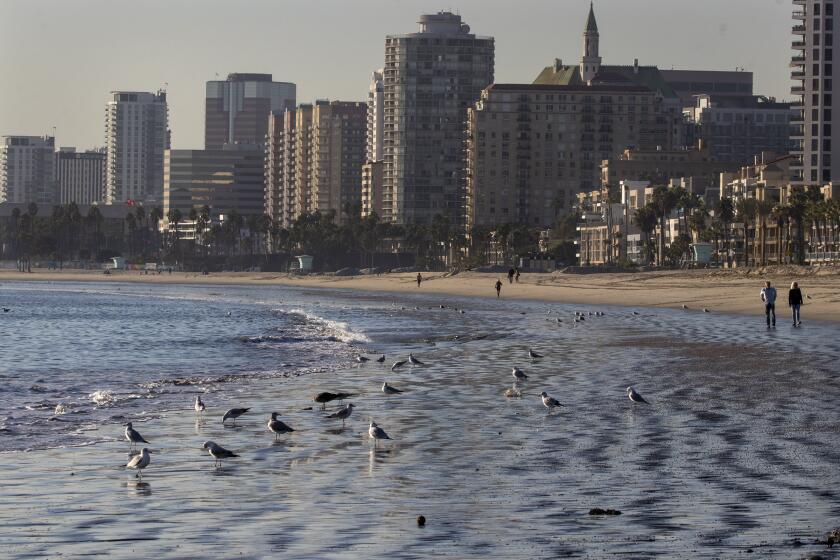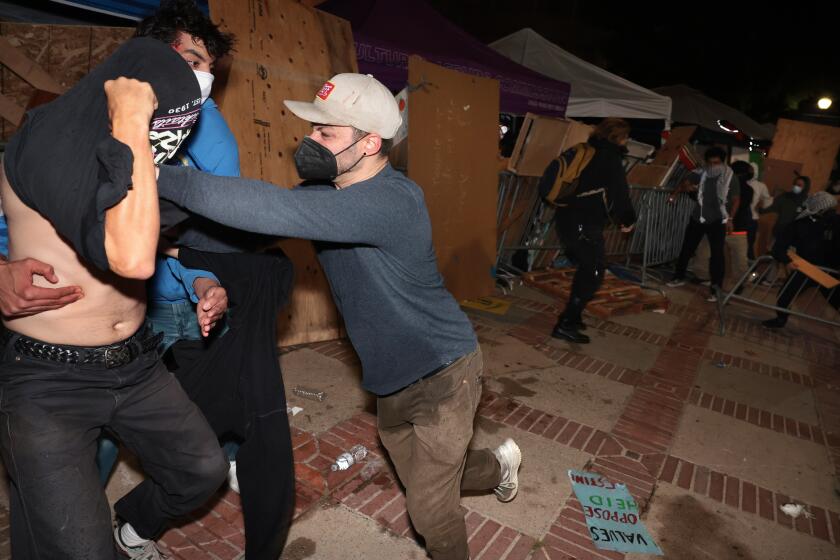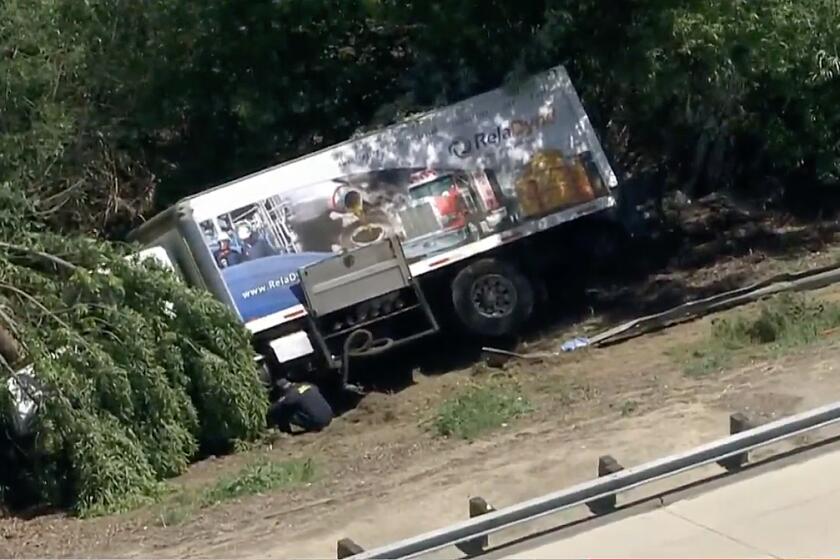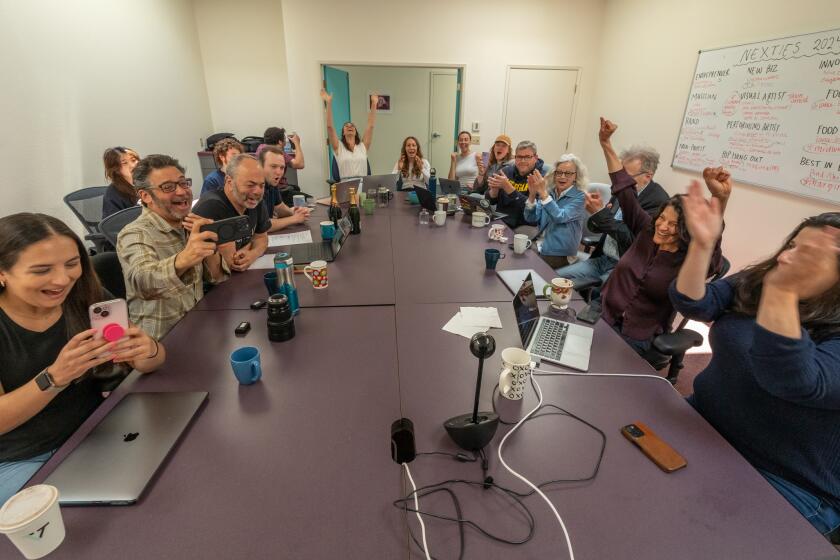L.A. Is Least Diverse Area in State, Study Finds
Californians are more likely to live among people of different races than they were in 1990, but the Los Angeles area stands out as the most segregated part of the state, according to an analysis of census data.
The percentage of California residents living in largely segregated neighborhoods dropped by almost half from 1990 to 2000, while the percentage of those in racially mixed areas more than doubled, according to the study by the Public Policy Institute of California, a San Francisco-based nonprofit research group.
The report said rapid Latino population growth pushed many heavily Latino cities and neighborhoods in Greater Los Angeles into the category of “segregated,” which it defined as one ethnic or racial group forming the overwhelming majority of residents in an area. An example would be South Gate, which, at 92% Latino, was ranked as the third most segregated community in the state.
The report, to be released Wednesday, does not employ the traditional definition of segregation, in which laws and racism kept people separated. The segregation it describes appears to be more the result of immigration and economic patterns.
“The nature of segregation, how and why it occurs, is very different,” said Hans P. Johnson of the Public Policy Institute, one of the study’s authors.
In 1990, 56% of the segregated neighborhoods in Los Angeles County were primarily white, according to the report. By 2000, 70% of the segregated neighborhoods were Latino.
During that period, however, the number of segregated neighborhoods in Los Angeles County declined. In 1990, 35% of Los Angeles neighborhoods were segregated, but by 2000 the percentage dropped to 26% of neighborhoods.
Latino immigration contributed to the overall drop in segregation as well as the creation of newly segregated neighborhoods. In cities such as Bellflower, neighborhoods that once had a white majority became more diverse as their Latino populations increased.
James P. Allen, a Cal State Northridge professor who studies the ethnic makeup of Los Angeles, said “segregation” is no longer an appropriate term to describe such population changes. “Segregation implies a rigid Jim Crow system separating blacks and whites,” he said.
Those who can afford to “are relatively free to leave those ethnic enclaves. It’s mostly voluntary and nothing pernicious,” Allen said of the growth in Latino communities. Thus Allen said he uses the term “separation” rather than segregation to describe the Los Angeles communities that have become less diverse.
Housing discrimination may be a lingering problem in the Los Angeles area, Allen said, but the growth of Latino cities and neighborhoods is due mainly to immigration. “A large number of immigrants is coming in, and they tend to prefer to live near some friend or relative,” he said.
The Public Policy Institute study found seven of California’s least diverse cities in Los Angeles County, all in the east and southeast portions of the county, which have long been a destination for Latinos. (Two other primarily white Southern California cities, Newport Beach and Encinitas, also made the list.)
The most diverse cities in California tend to be suburban areas, many in the San Francisco Bay Area. Diverse cities “tend to be fast-growing cities with plenty of new and relatively affordable housing,” the study noted. It added that “many of these integrated cities are the same places that are cited as examples of urban sprawl.”
In Southern California, San Bernardino County has the greatest proportion of diverse neighborhoods. Long Beach, Buena Park and Lakewood, along with Bellflower, also were identified as the most diverse communities.
The changes identified in the report are now obvious on the streets of Southern California, where long-held assumptions about segregation and integration were upset in the last two decades. Polyglot inner-city areas became Latino immigrant enclaves, while predominantly white suburbs became burgeoning multiracial boom towns.
Remnants of a diverse past linger in and around East Los Angeles, an unincorporated community identified in the study as the most segregated community in California.
Although it has always been a cornerstone of Mexican American culture, East Los Angeles had for much of the 20th century been home to thriving Jewish, Russian, Central European and Japanese American neighborhoods.
The handful of businesses that remain from those vanishing communities are on their last legs.
On 1st Street in Boyle Heights, the Otomi-san restaurant is the last Japanese eatery in the area. The 50-year-old lunch spot, with five stools at a counter and three booths, was empty at noon on a recent Friday. Hand-lettered signs on the walls in Japanese still highlight specials such as ginger pork and mackerel, but the tables hold shakers of pico de gallo and chile con limon. “Most of my customers are Latino now,” owner Akira Seino said.
Don T. Nakanishi, director of UCLA’s Asian American Studies Center, said East Los Angeles’ transformation shows the effects of integration and segregation. Nakanishi was born in a Japanese American hospital in Boyle Heights, and lived in the area until he graduated from Roosevelt High School and headed for Yale University in the 1960s.
As race-based housing restrictions eased and families that could afford to moved out, Nakanishi said, East Los Angeles became more of a starting point for recent immigrants.
Nakanishi recalls his childhood neighborhood being relatively more prosperous and racially mixed, with Jews, Latinos, Asian Americans and African Americans living near each other. But he attributes the difference partly to other areas being off-limits.
“Anything across the Los Angeles River was the Westside. When I was in high school, Monterey Park and Montebello were just barely integrated. You couldn’t think of moving there,” he said.
Today, Montebello is three-quarters Latino and the 10th most segregated city in the state, according to the Public Policy Institute report.
*
(BEGIN TEXT OF INFOBOX)
City Profiles
A new study finds dramatic differences in residential segregation in California. It ranked the communities with the greatest amount of diversity and the most intense amount of segregation.
California cities with the most diverse neighborhoods
City Pop. % % % % Asian- White Black Latino American
Vallejo 116,760 36 23.7 15.9 24.2
Pittsburg 56,769 43.5 18.9 32.2 12.6
Hayward 140,030 43 11 34.2 19
San Leandro 79,452 51.3 9.9 20.1 23
Fairfield 96,178 56.2 15 18.8 10.9
Sacramento 407,018 48.3 15.5 21.6 16.6
Bellflower 72,878 46.1 13.1 43.2 9.7
Moreno Valley 142,381 46.8 19.9 38.4 5.9
Union City 66,869 30.2 6.7 24 43.4
Richmond 99,216 31.4 36.1 26.5 12.3
California cities with the least diverse neighborhoods
City Pop. % % % % Asian- White Black Latino American
East L.A.* 124,283 39.3 0.4 96.8 0.8
Huntington Park 61,348 41.4 0.8 95.6 0.8
South Gate 96,345 41.6 1 92 0.8
Florence- Graham* 60,197 24.5 15.1 85.9 0.1
Pico Rivera 63,428 49.4 0.7 88.3 2.7
Newport Beach 70,032 92.2 0.5 4.7 4
Redding 80,865 88.7 1.1 5.4 3
Lynwood 69,845 33.6 13.5 82.3 0.8
Encinitas 58,014 88.6 0.6 14.8 3.1
Montebello 62,150 46.8 0.9 74.6 11.6
*Unincorporated portion of Los Angeles County
Note: In several communities, particularly ones with heavy Latino populations, totals add up to more than 100% because many people who identify themselves ethnically as Latinos check ‘White’ as their racial designation.
Source: Public Policy Institute of California and 2000 Census
More to Read
Start your day right
Sign up for Essential California for news, features and recommendations from the L.A. Times and beyond in your inbox six days a week.
You may occasionally receive promotional content from the Los Angeles Times.






